FRUSDR Update for Optimal Server Performance (INTEL Platform)
For several years, I have been administering a couple of servers on the INTEL platform on which the IIS is spinning, when I launch and operate it feels like a small plane is preparing to take off somewhere nearby. As it turned out, the reason is simple: FRUSDR is not configured correctly .
For optimal server performance, FRUSDR (Field Replaceable Unit / Sensor Data Record) needs to be updated and reconfigured .
Searching the network for instructions on updating and configuring FRUSDR did not give the proper result, so, having studied the documentation from INTEL, I decided to reduce everything into one article.
First, we need the firmware itself: it can be downloaded on the INTEL website . Unpack the downloaded archive onto a USB stick, for convenience it’s better to the root.
Check out the Update_Instructions.txt file (located in the archive you downloaded) - it describes the update process, as well as the minimum requirements for the DMC version to install this update. To check the current firmware version, go to the BIOS using F2.
The BIOS version is on the first tab.
BMC, FRUSDR, HSC, and ME versions are shown on the Server Management -> System Information page.
Next, go to Boot Manager and select Internal EFI shell.
You can enter the Internal EFI shell immediately if you call Boot Manager (F6) during system boot
Before loading EFI, you can cancel automatic startup.nsh (ESC key) for updating in 6 seconds for manual updating or wait for startup.nsh to start automatically updating BMC, BIOS, FRUSDR and ME, in this case all components will be updated, including and FRUSDR.
If for some reason startup.nsh did not start or you need to update individual components, then after loading EFI we type fs0: (if the USB drive was inserted during the boot process, first enter the map –r command so that the system recognizes the drive).
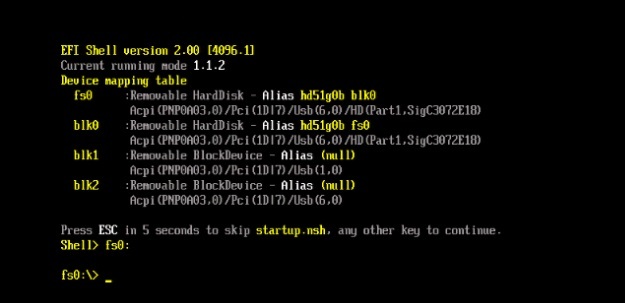
Using DOS or Linux commands, go to the directory where the unpacked service pack file is located. Using the dir * .nsh command, you can view the contents of a folder.

In this case, run BMC38 (depending on the version of the updated software, the file name may differ) to update BMC.
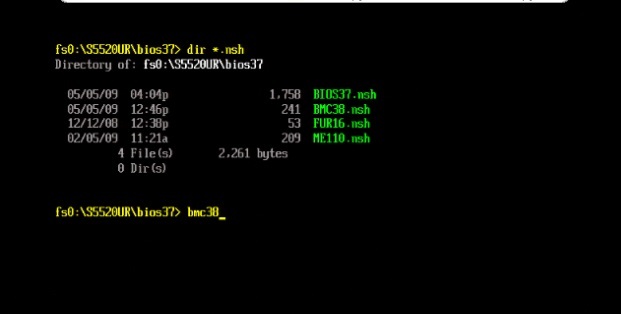
We are waiting for the end of the BMC update.
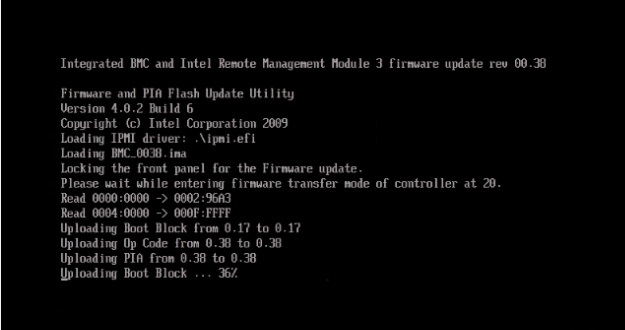
We enter bios37 (the file name may differ depending on the version of the updated software) in order to update the BIOS.
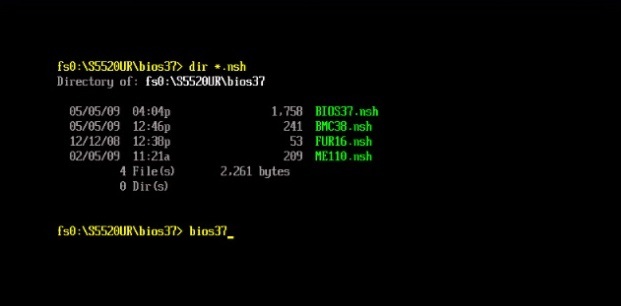
We are waiting for the BIOS update to complete.
Enter ME110 (the file name may differ depending on the version of the updated software) to update ME.
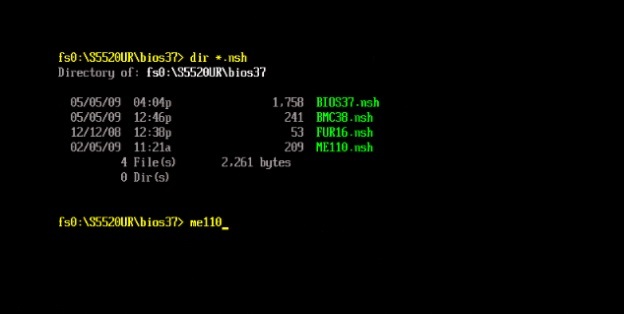
Introduce fur16 (depending on the version of the updated firmware file name may differ) to update FRUSDR. During the upgrade process, the user is prompted for configuration information. Incorrectly entered data during the upgrade process can lead to inefficient use of electricity and cooling system. Ensure that you have the necessary system configuration information before starting the upgrade process.
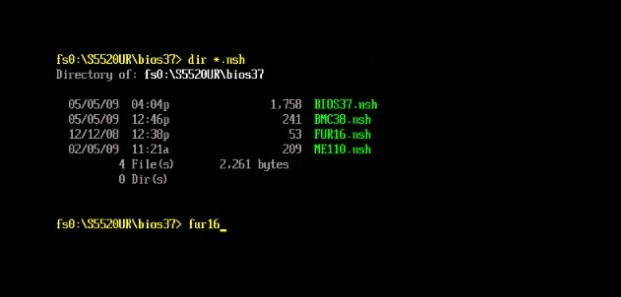
After running fur16.nsh, select the necessary items to update.
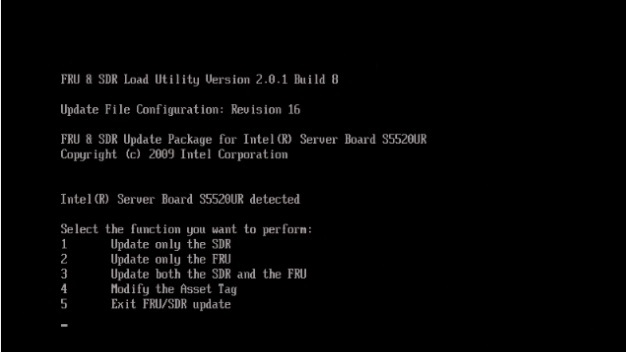
We are interested in point 3: Update both the SDR and the FRU.
Further, depending on the selected item, additional information will be requested.
Next, we are waiting for the update to complete, after which it will be offered to reboot the system using the power button on the front control panel.
We start the server, check the BIOS version, use it and enjoy the optimal operation of thecoolers of the cooling system.
PS: I took part of the screenshots from the INTEL demonstration, since there were no plans to write an article.
List of materials used:
Detailed instructions for updating FRUSDR ;
A short demonstration of software updates through EFI Shell.
For optimal server performance, FRUSDR (Field Replaceable Unit / Sensor Data Record) needs to be updated and reconfigured .
Searching the network for instructions on updating and configuring FRUSDR did not give the proper result, so, having studied the documentation from INTEL, I decided to reduce everything into one article.
So, let's start updating BMC, BIOS, FRUSDR and ME
First, we need the firmware itself: it can be downloaded on the INTEL website . Unpack the downloaded archive onto a USB stick, for convenience it’s better to the root.
Check out the Update_Instructions.txt file (located in the archive you downloaded) - it describes the update process, as well as the minimum requirements for the DMC version to install this update. To check the current firmware version, go to the BIOS using F2.
The BIOS version is on the first tab.
BIOS version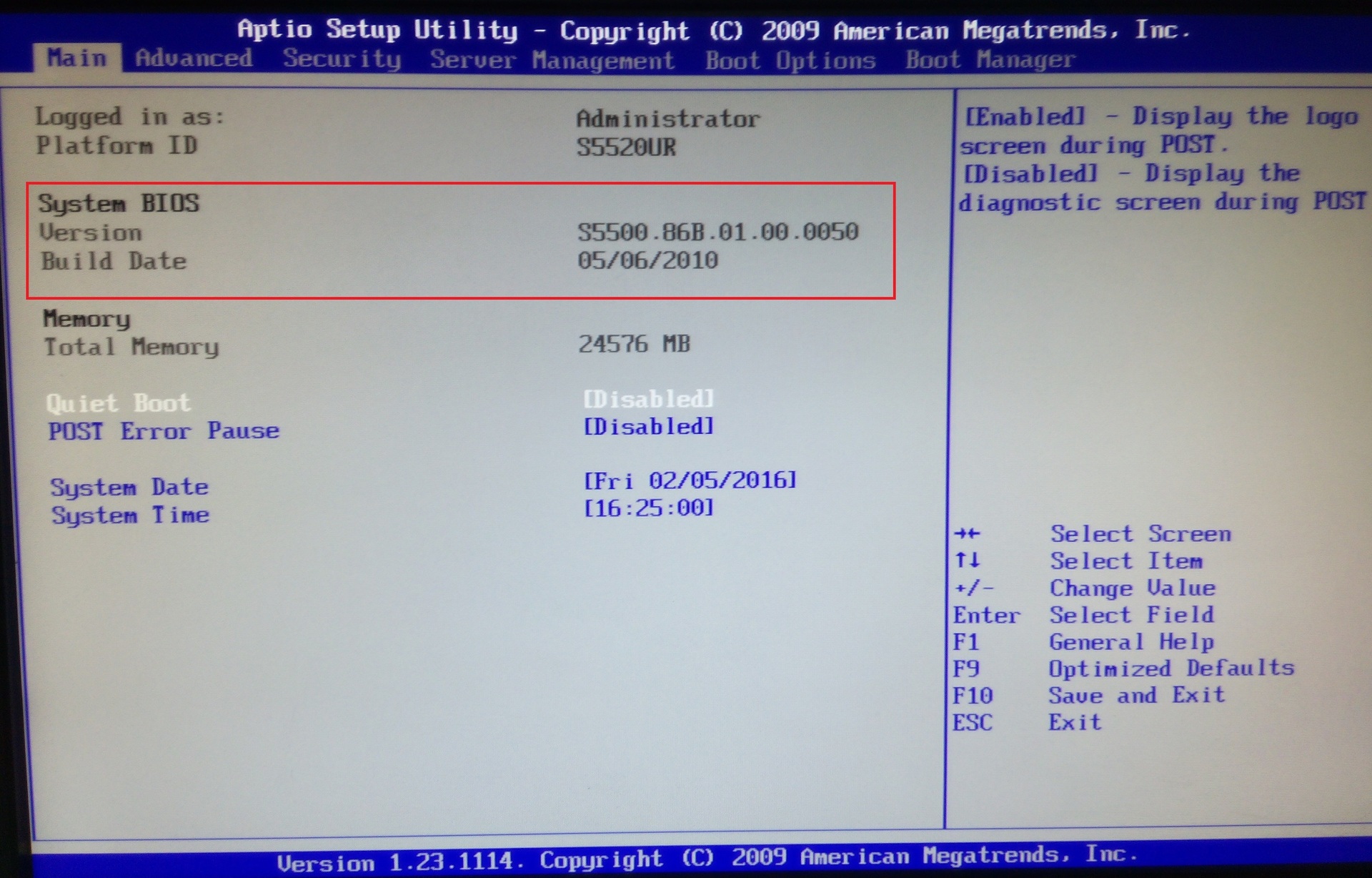

BMC, FRUSDR, HSC, and ME versions are shown on the Server Management -> System Information page.
System information
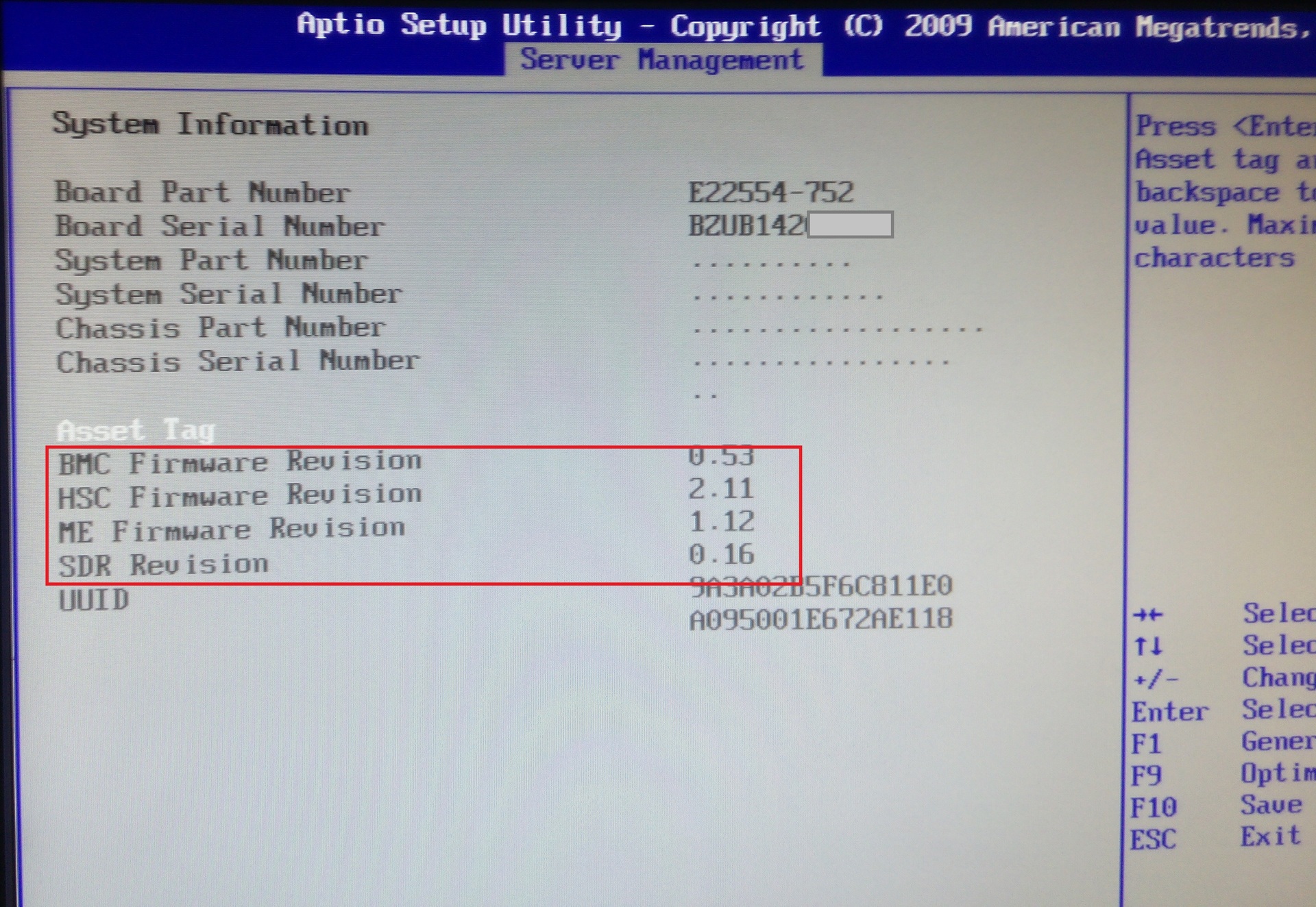


Next, go to Boot Manager and select Internal EFI shell.
Internal efi shell

You can enter the Internal EFI shell immediately if you call Boot Manager (F6) during system boot
Boot manager

Before loading EFI, you can cancel automatic startup.nsh (ESC key) for updating in 6 seconds for manual updating or wait for startup.nsh to start automatically updating BMC, BIOS, FRUSDR and ME, in this case all components will be updated, including and FRUSDR.
If for some reason startup.nsh did not start or you need to update individual components, then after loading EFI we type fs0: (if the USB drive was inserted during the boot process, first enter the map –r command so that the system recognizes the drive).

Using DOS or Linux commands, go to the directory where the unpacked service pack file is located. Using the dir * .nsh command, you can view the contents of a folder.

Updating BMC
In this case, run BMC38 (depending on the version of the updated software, the file name may differ) to update BMC.

We are waiting for the end of the BMC update.

Updating BIOS
We enter bios37 (the file name may differ depending on the version of the updated software) in order to update the BIOS.

We are waiting for the BIOS update to complete.
Updating ME
Enter ME110 (the file name may differ depending on the version of the updated software) to update ME.

FRUSDR Update
Introduce fur16 (depending on the version of the updated firmware file name may differ) to update FRUSDR. During the upgrade process, the user is prompted for configuration information. Incorrectly entered data during the upgrade process can lead to inefficient use of electricity and cooling system. Ensure that you have the necessary system configuration information before starting the upgrade process.

After running fur16.nsh, select the necessary items to update.

We are interested in point 3: Update both the SDR and the FRU.
Further, depending on the selected item, additional information will be requested.
Questions related to updating the SDR.
The the Chassis the Select ( Selecting the chassis ) *
1: the Intel® Server SR1600UR the Chassis
2: the Intel® Server SR1625UR the Chassis
3: the Intel® Server SR2600URBRP the Chassis
4: the Intel® Server SR2600URLX the Chassis
5: Other the Chassis
This information is required only in the case if you do not managed to automatically correctly identify the chassis. In this case, the user will have to select the desired answer.
If you select item 5: Other Chassis , the user must provide complete information about the configuration of the chassis in response to the following questions:
Q3: Does the system detect chassis intrusion? (Is there a tamper sensor?)
Q4: Does the front panel support a NMI button? (
Is there an NMI button on the front panel?) Q5: Is CPU Fan 1 installed? (
Is there a CPU Fan 1?) Q6: Is Memory Fan 1 installed? (In Stock Memory Fan?)
Q7: Is System Fan 1 installed? (Availability of System Fan?)
1: the Intel® Server SR1600UR the Chassis
2: the Intel® Server SR1625UR the Chassis
3: the Intel® Server SR2600URBRP the Chassis
4: the Intel® Server SR2600URLX the Chassis
5: Other the Chassis
This information is required only in the case if you do not managed to automatically correctly identify the chassis. In this case, the user will have to select the desired answer.
If you select item 5: Other Chassis , the user must provide complete information about the configuration of the chassis in response to the following questions:
Q3: Does the system detect chassis intrusion? (Is there a tamper sensor?)
Q4: Does the front panel support a NMI button? (
Is there an NMI button on the front panel?) Q5: Is CPU Fan 1 installed? (
Is there a CPU Fan 1?) Q6: Is Memory Fan 1 installed? (In Stock Memory Fan?)
Q7: Is System Fan 1 installed? (Availability of System Fan?)
Questions related to updating FRU
Do you want to update the chassis info area of the FRU (Y / N)? (Do you want to update the chassis information in FRU?)
If Yes, then additional questions will be asked.
Do you want to enter the chassis serial number (Y / N)? (Do you want to indicate the serial number of the chassis?)
Do you want to enter the chassis part number (Y / N)? (
Do you want to enter the chassis lot number) Do you want to enter data into the additional chassis field 1 (Y / N)? (
Do you want to enter additional chassis field 2 ) Do you want to enter data into the additional chassis field 2 (Y / N)? (
Do you want to enter an additional chassis field 2) Do you want to update the product info area of the FRU (Y / N)? (You want to update product information (motherboard ) in FRU?)
If Yes, then additional questions will be asked
Do you want to enter the product part number (Y / N)? (
Do you want to enter the product serial number (model )) Do you want to enter the product serial number (Y / N)? (
Do you want to enter the product serial number Do you want to enter a product asset tag (Y / N)? ( Do you want to enter the product asset tag )
If Yes, then additional questions will be asked.
Do you want to enter the chassis serial number (Y / N)? (Do you want to indicate the serial number of the chassis?)
Do you want to enter the chassis part number (Y / N)? (
Do you want to enter the chassis lot number) Do you want to enter data into the additional chassis field 1 (Y / N)? (
Do you want to enter additional chassis field 2 ) Do you want to enter data into the additional chassis field 2 (Y / N)? (
Do you want to enter an additional chassis field 2) Do you want to update the product info area of the FRU (Y / N)? (You want to update product information (
If Yes, then additional questions will be asked
Do you want to enter the product part number (Y / N)? (
Do you want to enter the product serial number (
Do you want to enter the product serial number Do you want to enter a product asset tag (Y / N)? ( Do you want to enter the product asset tag )
Next, we are waiting for the update to complete, after which it will be offered to reboot the system using the power button on the front control panel.
We start the server, check the BIOS version, use it and enjoy the optimal operation of the
PS: I took part of the screenshots from the INTEL demonstration, since there were no plans to write an article.
List of materials used:
Detailed instructions for updating FRUSDR ;
A short demonstration of software updates through EFI Shell.
